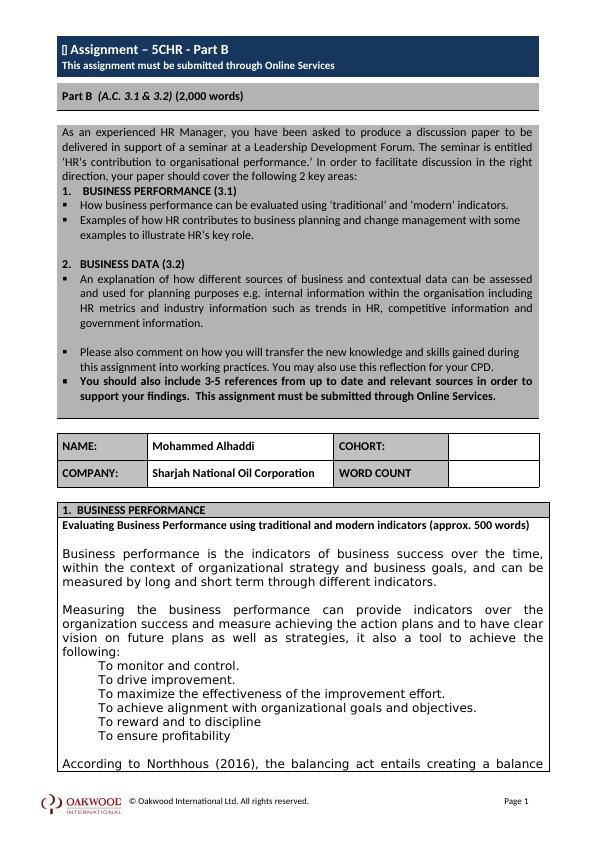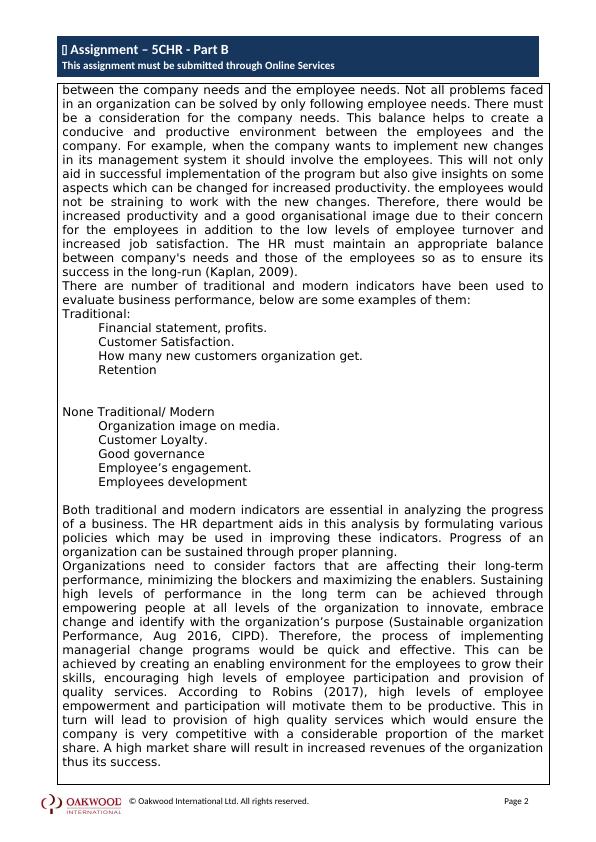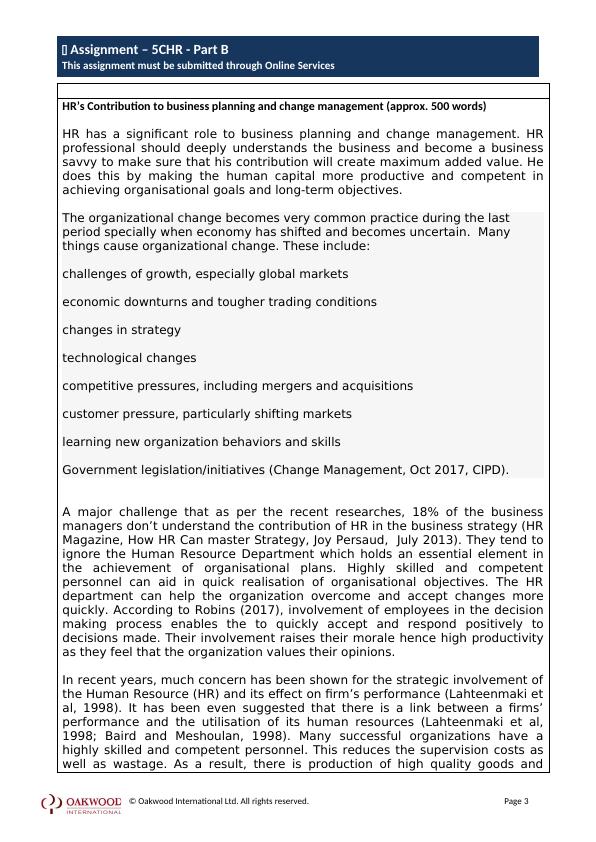HR's Contribution to Organisational Performance
Added on 2023-05-28
9 Pages3378 Words271 Views
Assignment – 5CHR - Part B
This assignment must be submitted through Online Services
Part B (A.C. 3.1 & 3.2) (2,000 words)
As an experienced HR Manager, you have been asked to produce a discussion paper to be
delivered in support of a seminar at a Leadership Development Forum. The seminar is entitled
‘HR’s contribution to organisational performance.’ In order to facilitate discussion in the right
direction, your paper should cover the following 2 key areas:
1. BUSINESS PERFORMANCE (3.1)
How business performance can be evaluated using ‘traditional’ and ‘modern’ indicators.
Examples of how HR contributes to business planning and change management with some
examples to illustrate HR’s key role.
2. BUSINESS DATA (3.2)
An explanation of how different sources of business and contextual data can be assessed
and used for planning purposes e.g. internal information within the organisation including
HR metrics and industry information such as trends in HR, competitive information and
government information.
Please also comment on how you will transfer the new knowledge and skills gained during
this assignment into working practices. You may also use this reflection for your CPD.
You should also include 3-5 references from up to date and relevant sources in order to
support your findings. This assignment must be submitted through Online Services.
NAME: Mohammed Alhaddi COHORT:
COMPANY: Sharjah National Oil Corporation WORD COUNT
1. BUSINESS PERFORMANCE
Evaluating Business Performance using traditional and modern indicators (approx. 500 words)
Business performance is the indicators of business success over the time,
within the context of organizational strategy and business goals, and can be
measured by long and short term through different indicators.
Measuring the business performance can provide indicators over the
organization success and measure achieving the action plans and to have clear
vision on future plans as well as strategies, it also a tool to achieve the
following:
To monitor and control.
To drive improvement.
To maximize the effectiveness of the improvement effort.
To achieve alignment with organizational goals and objectives.
To reward and to discipline
To ensure profitability
According to Northhous (2016), the balancing act entails creating a balance
© Oakwood International Ltd. All rights reserved. Page 1
This assignment must be submitted through Online Services
Part B (A.C. 3.1 & 3.2) (2,000 words)
As an experienced HR Manager, you have been asked to produce a discussion paper to be
delivered in support of a seminar at a Leadership Development Forum. The seminar is entitled
‘HR’s contribution to organisational performance.’ In order to facilitate discussion in the right
direction, your paper should cover the following 2 key areas:
1. BUSINESS PERFORMANCE (3.1)
How business performance can be evaluated using ‘traditional’ and ‘modern’ indicators.
Examples of how HR contributes to business planning and change management with some
examples to illustrate HR’s key role.
2. BUSINESS DATA (3.2)
An explanation of how different sources of business and contextual data can be assessed
and used for planning purposes e.g. internal information within the organisation including
HR metrics and industry information such as trends in HR, competitive information and
government information.
Please also comment on how you will transfer the new knowledge and skills gained during
this assignment into working practices. You may also use this reflection for your CPD.
You should also include 3-5 references from up to date and relevant sources in order to
support your findings. This assignment must be submitted through Online Services.
NAME: Mohammed Alhaddi COHORT:
COMPANY: Sharjah National Oil Corporation WORD COUNT
1. BUSINESS PERFORMANCE
Evaluating Business Performance using traditional and modern indicators (approx. 500 words)
Business performance is the indicators of business success over the time,
within the context of organizational strategy and business goals, and can be
measured by long and short term through different indicators.
Measuring the business performance can provide indicators over the
organization success and measure achieving the action plans and to have clear
vision on future plans as well as strategies, it also a tool to achieve the
following:
To monitor and control.
To drive improvement.
To maximize the effectiveness of the improvement effort.
To achieve alignment with organizational goals and objectives.
To reward and to discipline
To ensure profitability
According to Northhous (2016), the balancing act entails creating a balance
© Oakwood International Ltd. All rights reserved. Page 1

Assignment – 5CHR - Part B
This assignment must be submitted through Online Services
between the company needs and the employee needs. Not all problems faced
in an organization can be solved by only following employee needs. There must
be a consideration for the company needs. This balance helps to create a
conducive and productive environment between the employees and the
company. For example, when the company wants to implement new changes
in its management system it should involve the employees. This will not only
aid in successful implementation of the program but also give insights on some
aspects which can be changed for increased productivity. the employees would
not be straining to work with the new changes. Therefore, there would be
increased productivity and a good organisational image due to their concern
for the employees in addition to the low levels of employee turnover and
increased job satisfaction. The HR must maintain an appropriate balance
between company's needs and those of the employees so as to ensure its
success in the long-run (Kaplan, 2009).
There are number of traditional and modern indicators have been used to
evaluate business performance, below are some examples of them:
Traditional:
Financial statement, profits.
Customer Satisfaction.
How many new customers organization get.
Retention
None Traditional/ Modern
Organization image on media.
Customer Loyalty.
Good governance
Employee’s engagement.
Employees development
Both traditional and modern indicators are essential in analyzing the progress
of a business. The HR department aids in this analysis by formulating various
policies which may be used in improving these indicators. Progress of an
organization can be sustained through proper planning.
Organizations need to consider factors that are affecting their long-term
performance, minimizing the blockers and maximizing the enablers. Sustaining
high levels of performance in the long term can be achieved through
empowering people at all levels of the organization to innovate, embrace
change and identify with the organization’s purpose (Sustainable organization
Performance, Aug 2016, CIPD). Therefore, the process of implementing
managerial change programs would be quick and effective. This can be
achieved by creating an enabling environment for the employees to grow their
skills, encouraging high levels of employee participation and provision of
quality services. According to Robins (2017), high levels of employee
empowerment and participation will motivate them to be productive. This in
turn will lead to provision of high quality services which would ensure the
company is very competitive with a considerable proportion of the market
share. A high market share will result in increased revenues of the organization
thus its success.
© Oakwood International Ltd. All rights reserved. Page 2
This assignment must be submitted through Online Services
between the company needs and the employee needs. Not all problems faced
in an organization can be solved by only following employee needs. There must
be a consideration for the company needs. This balance helps to create a
conducive and productive environment between the employees and the
company. For example, when the company wants to implement new changes
in its management system it should involve the employees. This will not only
aid in successful implementation of the program but also give insights on some
aspects which can be changed for increased productivity. the employees would
not be straining to work with the new changes. Therefore, there would be
increased productivity and a good organisational image due to their concern
for the employees in addition to the low levels of employee turnover and
increased job satisfaction. The HR must maintain an appropriate balance
between company's needs and those of the employees so as to ensure its
success in the long-run (Kaplan, 2009).
There are number of traditional and modern indicators have been used to
evaluate business performance, below are some examples of them:
Traditional:
Financial statement, profits.
Customer Satisfaction.
How many new customers organization get.
Retention
None Traditional/ Modern
Organization image on media.
Customer Loyalty.
Good governance
Employee’s engagement.
Employees development
Both traditional and modern indicators are essential in analyzing the progress
of a business. The HR department aids in this analysis by formulating various
policies which may be used in improving these indicators. Progress of an
organization can be sustained through proper planning.
Organizations need to consider factors that are affecting their long-term
performance, minimizing the blockers and maximizing the enablers. Sustaining
high levels of performance in the long term can be achieved through
empowering people at all levels of the organization to innovate, embrace
change and identify with the organization’s purpose (Sustainable organization
Performance, Aug 2016, CIPD). Therefore, the process of implementing
managerial change programs would be quick and effective. This can be
achieved by creating an enabling environment for the employees to grow their
skills, encouraging high levels of employee participation and provision of
quality services. According to Robins (2017), high levels of employee
empowerment and participation will motivate them to be productive. This in
turn will lead to provision of high quality services which would ensure the
company is very competitive with a considerable proportion of the market
share. A high market share will result in increased revenues of the organization
thus its success.
© Oakwood International Ltd. All rights reserved. Page 2

Assignment – 5CHR - Part B
This assignment must be submitted through Online Services
HR’s Contribution to business planning and change management (approx. 500 words)
HR has a significant role to business planning and change management. HR
professional should deeply understands the business and become a business
savvy to make sure that his contribution will create maximum added value. He
does this by making the human capital more productive and competent in
achieving organisational goals and long-term objectives.
The organizational change becomes very common practice during the last
period specially when economy has shifted and becomes uncertain. Many
things cause organizational change. These include:
challenges of growth, especially global markets
economic downturns and tougher trading conditions
changes in strategy
technological changes
competitive pressures, including mergers and acquisitions
customer pressure, particularly shifting markets
learning new organization behaviors and skills
Government legislation/initiatives (Change Management, Oct 2017, CIPD).
A major challenge that as per the recent researches, 18% of the business
managers don’t understand the contribution of HR in the business strategy (HR
Magazine, How HR Can master Strategy, Joy Persaud, July 2013). They tend to
ignore the Human Resource Department which holds an essential element in
the achievement of organisational plans. Highly skilled and competent
personnel can aid in quick realisation of organisational objectives. The HR
department can help the organization overcome and accept changes more
quickly. According to Robins (2017), involvement of employees in the decision
making process enables the to quickly accept and respond positively to
decisions made. Their involvement raises their morale hence high productivity
as they feel that the organization values their opinions.
In recent years, much concern has been shown for the strategic involvement of
the Human Resource (HR) and its effect on firm’s performance (Lahteenmaki et
al, 1998). It has been even suggested that there is a link between a firms’
performance and the utilisation of its human resources (Lahteenmaki et al,
1998; Baird and Meshoulan, 1998). Many successful organizations have a
highly skilled and competent personnel. This reduces the supervision costs as
well as wastage. As a result, there is production of high quality goods and
© Oakwood International Ltd. All rights reserved. Page 3
This assignment must be submitted through Online Services
HR’s Contribution to business planning and change management (approx. 500 words)
HR has a significant role to business planning and change management. HR
professional should deeply understands the business and become a business
savvy to make sure that his contribution will create maximum added value. He
does this by making the human capital more productive and competent in
achieving organisational goals and long-term objectives.
The organizational change becomes very common practice during the last
period specially when economy has shifted and becomes uncertain. Many
things cause organizational change. These include:
challenges of growth, especially global markets
economic downturns and tougher trading conditions
changes in strategy
technological changes
competitive pressures, including mergers and acquisitions
customer pressure, particularly shifting markets
learning new organization behaviors and skills
Government legislation/initiatives (Change Management, Oct 2017, CIPD).
A major challenge that as per the recent researches, 18% of the business
managers don’t understand the contribution of HR in the business strategy (HR
Magazine, How HR Can master Strategy, Joy Persaud, July 2013). They tend to
ignore the Human Resource Department which holds an essential element in
the achievement of organisational plans. Highly skilled and competent
personnel can aid in quick realisation of organisational objectives. The HR
department can help the organization overcome and accept changes more
quickly. According to Robins (2017), involvement of employees in the decision
making process enables the to quickly accept and respond positively to
decisions made. Their involvement raises their morale hence high productivity
as they feel that the organization values their opinions.
In recent years, much concern has been shown for the strategic involvement of
the Human Resource (HR) and its effect on firm’s performance (Lahteenmaki et
al, 1998). It has been even suggested that there is a link between a firms’
performance and the utilisation of its human resources (Lahteenmaki et al,
1998; Baird and Meshoulan, 1998). Many successful organizations have a
highly skilled and competent personnel. This reduces the supervision costs as
well as wastage. As a result, there is production of high quality goods and
© Oakwood International Ltd. All rights reserved. Page 3

End of preview
Want to access all the pages? Upload your documents or become a member.
Related Documents
HR's Contribution to Organisational Performancelg...
|9
|3219
|67
HR's Contribution to Organisational Performance: Business Performance and Business Data Analysislg...
|9
|3621
|391
How HR Supports Organisational Performance - Deskliblg...
|8
|3751
|118
Organisational Design and Sustainable Performance: A Critical Analysis of Body Imagelg...
|7
|3432
|300
Relationship between Sustainable Organisational Performance and Strategic Alignmentlg...
|7
|3757
|121
Main Theories and Principles of Organisation Developmentlg...
|5
|2154
|429
